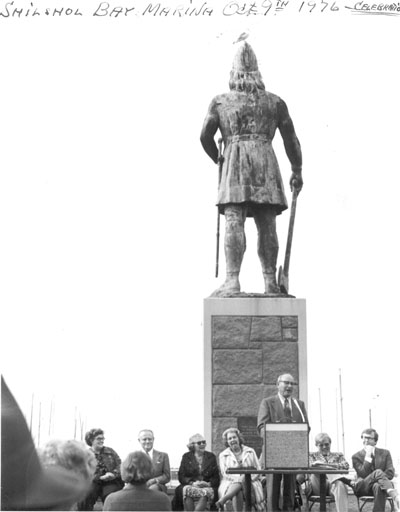
The Saga of Seattle’s Leif Erikson Statue (continued)
One of the League’s unsuccessful endeavors was a campaign to have a new junior college named after Leif. Delegates wrote letters in vain, hoping that one of two new planned junior colleges in Auburn or Tacoma, or a new college proposed by Nakkerud on the westward slope of Seattle’s Fort Lawton, could be named Leif Erikson Junior College.
On April 20, 1977, the Leif Erikson League wrote to the Port, requesting that the name of the League’s president be added to the base of the statue. The Port hired Quiring Monument to make the addition, and on July 29, 1977, the superintendent of the Marina wrote to the League to say that the name Trygve Nakkerud had been added to the plaque. 13

Leif Erikson statue at Shilshole. Trygve Nakkerud is at the podium
and Norwegian Consul Tom Stang is on Trygve's left. The event
was the Bicentennial World Marine Festival, October 9, 1976.
Hearsay had it that the League, and Nakkerud in particular, requested that the Port clean the statue prior to every visit by a Norwegian dignitary, which was actually damaging the statue. Indeed, the files at Shilshole Marina indicate that he continued to write the Port often to thank them for their upkeep of the statue and the area around it. A memo dated August 26, 1985, from Greg Money, Marina Supervisor, to the Port staff reported that the Leif Erikson League and Port had reached an agreement whereby the statue would not be cleaned and would be allowed to weather naturally. Nonetheless, the Leif Erikson statue has been used as a setting for numerous public festivals, from dancing by the local Leikarringen dance group to speeches on celebration days to the Western destination for a Norwegian traveling cross-country on horseback.
The saga of the Leif Erikson statue is typical in the conflict, rivalry, and strong opinions it engendered when it was created, as well as in its popularity with the public now. Public art has a predictable life cycle, explains Steve Mesler, local sculptor and foundry manager.14 Initially, Mesler points out, public art often attracts strong opinions, both pro and con. That’s understandable. Art and artistic taste are subjective. One man’s heroic Viking is another’s “football player in a Viking helmet.” Also, public art must be financed and managed, which brings up the question of whose vision it is—the artist’s, the donors’, the project managers’, or the recipient’s? And who gets credit? Historic details, particularly if they’re wrong, become a distraction and annoyance. Ownership and later upkeep are issues that can stall or dissolve public art projects before they begin. Public art is also often the brainchild of one person, who must be single-minded enough to hold the vision, promote the project, raise the funds, and push through objections, inertia, and so on. But individuals with strong opinions draw critics, particularly among Scandinavians who were raised on janteloven (the historical Scandinavian belief that no one is better than anyone else, and there should be “no tall poppies.”)
According to Mesler, once conflict arises, both sides steadfastly hold their opinions as long as they are involved. However, after the public discovers and begins to own the sculpture—making accurate the term “public art”—it often becomes nearly universally popular. Gone are the issues of artistic merit, historical accuracy, vision, ownership, and so on. Instead the work becomes familiar and appreciated simply for its presence. It’s loved because it’s there.
The Leif Erikson statue is a beloved part of the Shilshole waterfront. In 2002, when the Port of Seattle announced plans for a renovation of the marina, the public proclaimed that Leif should remain. But according to the Leif Erikson International Foundation, which is working with the Port on a new base and setting for the statue, this time around plaques will bear the names of both August Werner and Trygve Nakkerud.
- Marie Sherwin. “A Short History of the Leif Erikson League, Incorporated, of the Seattle Area.” (1968) Archives of the Leif Erikson League, PLU Collection.
- Program of the Leif Erikson Festival (October 9, 1960). Archives of the Leif Erikson League, PLU Collection.
- “Bronze Figure Is Memorial to Scandinavians.” (Seattle: Daily Journal of Commerce, December 14, 1962.)
- David Suffia. “Seattle’s Historical Markers, Leif Erikson Statue.” (Seattle: The Seattle Times, June 4, 1973.)
- Louis R. Guzzo. “Site Remains Problem in Erikson-Statue Plan.” (Seattle: The Seattle Times, Friday, March 13, 1959.)
- Louis R. Guzzo. “After Stormy Voyage, Ericson League Sights Land at Last.” (Seattle: The Seattle Times, Friday, November 18, 1960.)
- Ibid.
- John Raymond. “Famed Viking Statue Cast in Bronze by Berkeleyan.” (San Francisco: American Scandinavian, June 15, 1962.)
- Correspondence from Ted Nakkerud of the Leif Erikson League to Shilshole Bay Marina (Seattle: July 9, 1968). Shilshole Bay Marina files.
- C. L. Anderson (Seattle: The Seattle Times), June 18, 1962.
- “Bronze Statue of Leif Erikson Unveiled at Shilshole Bay,” probably Seattle Times, probably June 18, 1962. PLU Archives.
- “Leif Erikson Statue Will Go on Charts.” (Marine Digest, May 4, 1963.) UW Archives.
- Correspondence from Winslow H. Buxton of the Shilshole Bay Marina to Asbjorn Nordheim, Leif Erikson League, Inc. (Seattle: July 29, 1977). Shilshole Bay Marina files.
- Conversation with Steve Mesler (Seattle, July 2000).